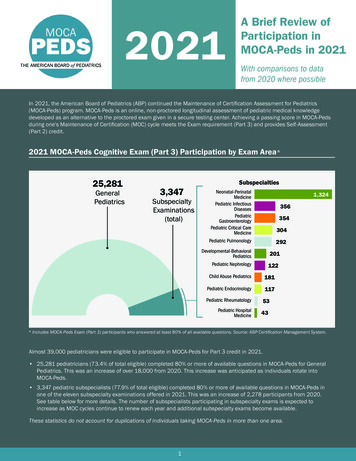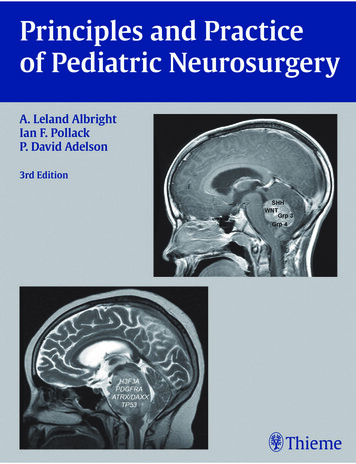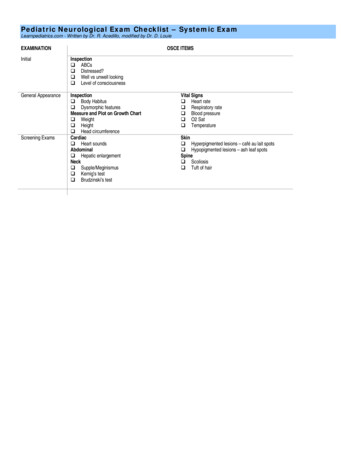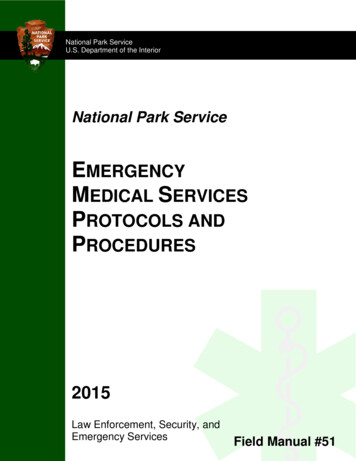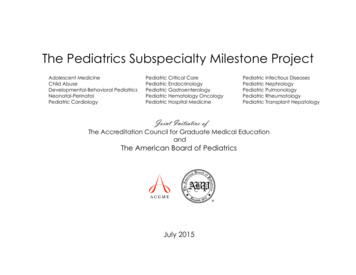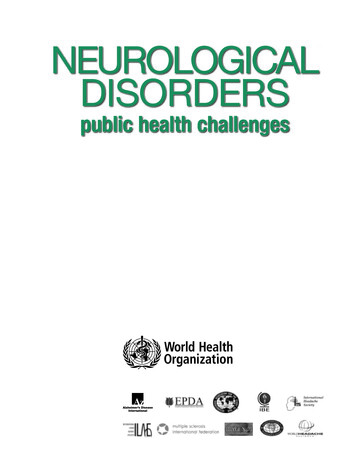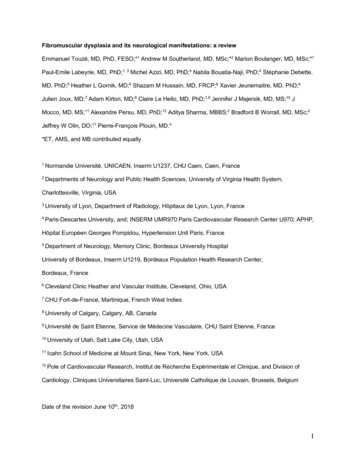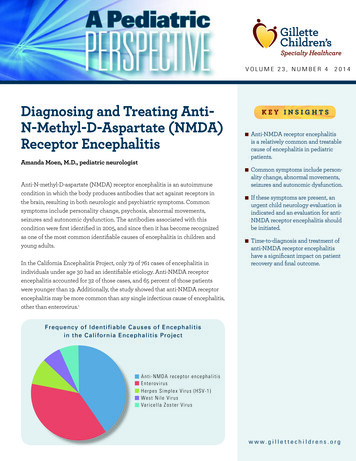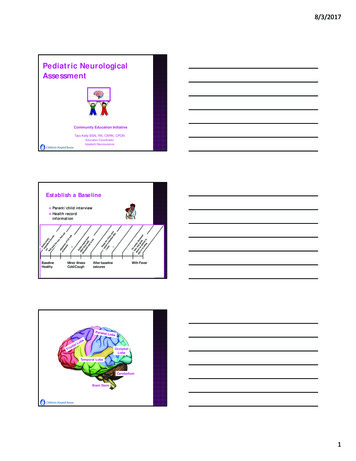
Transcription
8/3/2017Pediatric NeurologicalAssessmentCommunity Education InitiativeTara Kelly BSN, RN, CNRN, CPONEducation CoordinatorInpatient NeuroscienceEstablish a Baseline Parent/child interviewHealth recordinformationBaselineHealthyMinor illnessCold/CoughAfter baselineseizuresWith FeverOccipitalLobeTemporal LobeCerebellumBrain Stem1
8/3/2017Clockwise rotationUse RIGHT side of brain Imaginative See the “big picture” Philosophy & religion Appreciates Knows object function Fantasy Present possibilities Impetuous Risk takingCounterclockwiseUse LEFT side of Brain Factual Detail oriented Math & science Order, patterns Knows object name Reality Form strategies Practical SafeThe Frontal Lobe Executivefunctioning Personality Judgment Reasoning Motorfunction Speech Memory OlfactoryreceptionThe Parietal Lobe Primarysensory area Awarenessof one’s ownbody parts Spatialconcepts2
8/3/2017The Temporal Lobe Primaryauditory area Receptivespeech MemoryThe Occipital Lobe Perceptionandinterpretation of visionThe Cerebellum Integratessensoryperception &motor movement3
8/3/2017The Cerebellum Finemotor movementhand movements Point to point movement Gait AlternatingMotor Assessment Observation Symmetry, atrophy, involuntary movements Strength Pronator drift Tone& reflexesSensory Assessment Lighttouch Temperature Pain Vibration Proprioception4
8/3/2017The Brainstem Midbrain Pons MedullaCranial Nerve Assessment I II OlfactorySmellOpticVisual acuity and fields5
8/3/2017Cranial Nerve Assessment III IV TrochlearEye movement VI OculomotorPERRLAPtosisEye movementAbducensEye movementExtra-Ocular MovementsCranial Nerve Assessment V TrigeminalBlink reflexFacial sensationMassetter musclestrength6
8/3/2017ABCEDCranial Nerve Assessment VII FacialSymmetry of facial expressionSalivary function & tasteTearingCranial Nerve Assessment VIII VestibulocochlearHearingBalance7
8/3/2017Cranial Nerve Assessment IX XII Glossopharyngeal & X VagusSpeechSwallowGagPalateVital organ mechanicsHypoglossalTongue movementCranial Nerve Assessment XI AccessoryHead, neck & shoulder strengthGlasgow Coma Scale8
8/3/2017Mini Mental Status ExamNeuro Assessment in 3 StepsCompare to Baseline Neuro Assessment1. Mental status Is child acting appropriately? Engage child in conversation Elicit highest level of functioning2. Cranial Nerves Eyes Facial symmetry Speech3. Motor/Sensory Strength, balance SensationRed Flags for School Nurses Persistent nausea & vomiting Focal neurological deficits Significant deterioration in child’s condition:Progressive somnolenceSlurred speechInability or difficulty walking Worsening mental status Findings suggestive of a skull fracture Palpable deformity, hemotympanum, CSF leakConcern for cervical spine injuryDeviation from Baseline9
8/3/2017CONCUSSION Alterationin mental status caused by direct orindirect force to the head or bodyhttp://www.youtube.com/watch?v Qq8XLD9kjzI&feature plcp&noredirect 1 Majority Often– NO loss of consciousnessunrecognized 80-90%resolve in a short period Childrenhave longer recovery times Children 5-18yearsBicycling, football, basketball, playground activities,soccer, hockey, ski/snowboarding History Lackof Concussionof proper diagnosis and management10
8/3/2017Signs ofConcussionAcuteConcussionAppropriateManagement3 symptom types: Cognitive Somatic/Physical Behavior/Emotional Hardtimeconcentrating Troubleremembering Mentally ‘foggy’ Confusion Speed of thinkingslowed down Taking a longer timeto react11
8/3/2017 Balanceproblems Headache Dizziness Nausea Poorcoordination Fatigue Sensitivityto brightlight and/or noise Sleep disturbancehttp://www.youtube.com/watch?v klESLYtbRe8&NR 1&feature endscreenhttp://www.youtube.com/watch?v yIqZDbk3M40&feature plcp Irritable Moreemotionalsad Feel nervous FeelAssessment Exclusionof more serious injury Standardizedobjective assessmentUse tools (SCAT3, Post Concussive SymptomScale) Serial assessments Clinical judgment Err on the side of caution 12
8/3/201713
8/3/2017 Massivebrain swelling Occursafter suffering a secondconcussion before symptoms of an earlierconcussion have subsided Incidencehighest in school age children Symptomsquickly progress Groupof somatic and cognitive symptoms(headache, vertigo, depression) Symptomslast few months up to 1 yearafter a concussion Diagnosticcriteria must be met Morecommon in high school athletes thanyoung childrenhttp://www.youtube.com/watch?v jy7pDSIEbBU&feature plcp Progressivedegeneration disease Accumulationof Tau Protein Symptoms of dementia May appear within monthsinjuriesto decades of the14
8/3/2017 NoReturn to play (RTP) PhysicalAND cognitive rest Gradedprogram of exertion prior toreturn to play CDC.gov/concussionHeads Up: brain injury in your practiceACE; school version CarePlan Acute – first 3 days of injuryEducation, brief cognitive screen, caregiveranxiety, no return to contact Post-Acute Long-term - 4 days -3 monthsBehavioral prescriptions, education, avoidfurther injury, accommodations andmodification, emotional toll of no sports- 4monthsComprehensive neuropsych eval, CBT, developstrategies, post-injury family dynamics, maybe non-injury related15
8/3/2017 Restbreaks Decreased Untimedschool and homework loadtests/no standardized tests Pre-printednotes Communication Expectstudent to look well and not ask forhelp!12456with parenthttp://www.youtube.com/watch?v pirBeouSHc0&feature plcpNo activity, complete rest. Onceasymptomatic, proceed to level 2.Light aerobic exercise such as walking orstationary cycling, no resistancetraining.Non-contact training drills.Full contact training after medicalclearance.Game play.If child develops signs of concussion at anytime,REST for 24hrs,then go backto the PREVIOUS ASYPTOMATIC STEP Prolongedsymptom management withmedication RTP should not occur while on medication thatmay mask/modify symptoms Prolongedsymptoms need to be managed by amultidisciplinary team with experience inconcussion Considerationof modifying factors16
8/3/2017 Whyis balance acutely affected?Immediate Post-ConcussiveAssessment and Cognitive Testing Objectiveevaluation of post-injurycondition Tracks recovery for safe RTP Measures verbal & visual memory,processing speed & reaction time17
8/3/2017 Identifying Advocatesigns & symptomsfor cognitive and physical rest Useof Step Wise Approach for return toactivity Referto Specialist if needed EDUCATION Resource: .com/watch?v 2fMCaSwb Fg&feature plcpRed Flags for School Nurses Prolonged HighLoss of ConsciousnessImpact Acuteworsening of child’s condition Actrelative to safety regulations in schoolathletic programs Developmentof an interscholastic head injurysafety training program DPH division of violence & injury preventionRequires annual participationCDC.gov/concussionNational Federation of State HSAssociation’s Concussion in ing/HeadsUpConcussion.html18
8/3/2017 Proper recovery from concussion Protective equipment Education Rule QuietCanKeepYouOutOfTheGame Mother.Questions?Thank you19
Strictly Clinical —Facing cranial nerveassessmentBy Barbara Bolek, APRN, MSN, CCRN, PCCNMANYYEARS AGO when I was inHow to rememberand assess the cranialnerves with easenursing school, I learned a sayingthat was supposed to help me recall the cranial nerves. You’veprobably heard it: On Old Olympus Towering Tops A Finn and German Viewed SomeHops. It didn’t make much sense to me, and it didn’thelp me remember the cranial nerves.A few years ago, a colleague taught me a mucheasier way to remember the cranial nerves and theirlocations—by drawing a face and using numbers asthe facial features. Each number represents one ofthe 12 cranial nerves, and the placement of thenumbers represents the location of or an association with them. (See Cranial nerves by thenumbers.)Olfactory nerve (CN I)Located in the nose, cranial nerve (CN) I controlsthe sense of smell. This nerve isn’t frequently tested,even by neurologists. However, suspect an abnormality in a neurologic patient who has a poor appetite.To assess the nerve, use soap and coffee—bothare easy to find on a unit. Or take a trip to thekitchen for cloves and vanilla. Don’t use a substancewith a harsh odor, such as ammonia, because it willstimulate the intranasal pain endings of CN V.Have the patient close both eyes, close one nostril, and gently inhale to smell the scent. Rememberto do both nostrils.Optic nerve (CN II)Located in and behind the eyes, CN II controls central and peripheral vision.The fovea in the center of the retina is responsiblefor visual acuity in our central vision. Test one eye ata time. Ask the patient to read his I.V. bag. Thenhave him count how many fingers you are holdingup 6 inches in front of him.Test peripheral vision one eye at a time, too. Cover one eye and instruct the patient to look at yournose. Move your index fingers to check the superiorand inferior fields one at a time. Ask the patient tonote any movement in the peripheral visual fields.Oculomotor nerve (CN III)Also positioned in and behind theeyes, CN III controls pupillary constriction.To test the patient’s pupils, dimthe lights, bring the light of the penlight from theoutside periphery to the center of each eye, andnote the response. Use the mm chart to describepupil size; descriptions such as “small,” “medium,”and “large” are too subjective.Also, check where the eyelid falls on the pupil. Ifit droops, note that the patient has ptosis.It’s easy to check cranial nerves III, IV, and VI together.Trochlear nerve (CN IV)Cranial nerve IV acts as a pulley to move the eyesdown—toward the tip of the nose.To assess the trochlear nerve, instruct the patientto follow your finger while you move it down toward his nose.Trigeminal nerve (CN V)Cranial nerve V covers most of the face.If a patient has a problem with this nerve, it usually involves the forehead, cheek, or jaw—the threeareas of the trigeminal nerve. Check sensation in allthree areas, using a soft and a dull object. Checksensation of the scalp, too.Test the motor function of the temporal and masseter muscles by assessing jaw opening strength. Ifyou suspect a problem with cranial nerves VI andVII, check the corneal reflex with a cotton wispsince it’s easy to do while you’re checking trigeminalnerve function.Abducens nerve (CN VI)Cranial nerve VI controls eye movement to thesides.Ask the patient to look toward each ear. Thenhave him follow your fingers through the six cardinal fields of gaze.Here’s another easy technique you can use: Withyour finger, make a big X in the air and then draw ahorizontal line across it. Observe the patient for nystagmus or twitching of the eye.November 2006American Nurse Today21
Facial nerve (CN VII)Cranial nerve VII controls facial movements andexpression.Assess the patient for facial symmetry. Have himwrinkle his forehead, close his eyes, smile, pucker hislips, show his teeth, and puff out his cheeks. Bothsides of the face should move the same way. WhenCheck hearing by rubbing your fingers together byeach ear.Glossopharyngeal nerve (CN IX) and vagus nerve(CN X)Cranial nerves IX and X, which innervate thetongue and throat (pharynx and larynx), arechecked together.Assess the sense of taste onthe back of the tongue. Observe the patient’s ability toCranial nerves by the numbersswallow by noting how heThe next time you’re trying to remember the locations and functions of the cranialhandles secretions. Ask the panerves, picture this drawing. All twelve cranial nerves are represented, thoughsome may be a little harder to spot than others. For example, the shoulders aretient to open his mouth andformed by the number “11” because cranial nerve XI controls neck and shouldersay AHHHHHH. The uvulamovement. If you immediately recognize that the sides of the face and the top ofshould be in the midline, andthe head are formed by the number “7,” you’re well on your way to using thisthe palate shouldmemory device.rise.Spinal accessory nerve(CN XI)This nerve controls neck andshoulder movement.Ask the patient to raise hisshoulders against your hands toassess the trapezius muscle.Then ask the patient to turn hishead against your hand to assess the sternocleidomastoidmuscle.Hypoglossal nerve(CN XII)Cranial nerve XII innervates thetongue.Ask the patient to stick outhis tongue. It should be in themidline.Look for problems with eating, swallowing, or speaking.You can check this nervewhen you check cranial nervesIX and X.So there you have it: NoOlympus, no Finn, and nohops. Just an easy way to remember—and check—the cranial nerves. Selected referencesthe patient smiles, observe the nasolabial folds forweakness or flattening.Acoustic nerve (CN VIII)Cranial nerve VIII, located in the ears, controls hearing.22American Nurse TodayNovember 2006Donohoe Dennison R. Pass CCRN! 2nd ed. St. Louis, Mo: Mosby;2000. Goldberg S. The Four-Minute Neurologic Exam. Miami, Fla:MedMaster Publishing Co; 2004.Barbara Bolek, APRN, MSN, CCRN, PCCN, is a Staff Development Specialist atProvena Saint Joseph Medical Center in Joliet, Illinois.
Acute Concussion Evaluation (ACE)Care PlanGerard Gioia, PhD1 & Micky Collins, PhD2Children’s National Medical CenterUniversity of Pittsburgh Medical Center12Patient Name:DOB:Date:Date of Injury:Age:ID/MR#You have been diagnosed with a concussion (also known as a mild traumatic brain injury). This personal plan is based onyour symptoms and is designed to help speed your recovery. Your careful attention to it can also prevent further injury.You should not participate in any high risk activities (e.g., sports, physical education (PE), riding a bike, etc.) if you stillhave any of the symptoms below. It is important to limit activities that require a lot of thinking or concentration (homework,job-related activities), as this can also make your symptoms worse. If you no longer have any symptoms and believe thatyour concentration and thinking are back to normal, you can slowly and carefully return to your daily activities. Childrenand teenagers will need help from their parents, teachers, coaches, or athletic trainers to help monitor their recovery andreturn to activities.Today the following symptoms are present (circle or check).— SCHOOL VERSION —PhysicalNo reported symptomsThinkingEmotionalSleepHeadachesSensitivity to lightFeeling mentally foggyIrritabilityDrowsinessNauseaSensitivity to noiseProblems concentratingSadnessSleeping more than usualFatigueNumbness/TinglingProblems rememberingFeeling more emotionalSleeping less than usualVisual problemsVomitingFeeling more slowed downNervousnessTrouble falling asleepBalance ProblemsDizzinessRED FLAGS: Call your doctor or go to your emergency department if you suddenly experience any of the followingHeadaches that worsenLook very drowsy, can’t be awakenedCan’t recognize people or placesUnusual behavior changeSeizuresRepeated vomitingIncreasing confusionIncreasing irritabilityNeck painSlurred speechWeakness or numbness in arms or legsLoss of consciousnessReturning to Daily Activities1. Get lots of rest. Be sure to get enough sleep at night- no late nights. Keep the same bedtime weekdays and weekends.2. Take daytime naps or rest breaks when you feel tired or fatigued.3. Limit physical activity as well as activities that require a lot of thinking or concentration. These activities canmake symptoms worse. Physical activity includes PE, sports practices, weight-training, running, exercising, heavy lifting, etc. Thinking and concentration activities (e.g., homework, classwork load, job-related activity).4. Drink lots of fluids and eat carbohydrates or protein to main appropriate blood sugar levels.5. As symptoms decrease, you may begin to gradually return to your daily activities. If symptoms worsen orreturn, lessen your activities, then try again to increase your activities gradually.6. During recovery, it is normal to feel frustrated and sad when you do not feel right and you can’t be as active as usual.7. Repeated evaluation of your symptoms is recommended to help guide recovery.Returning to School1. If you (or your child) are still having symptoms of concussion you may need extra help to perform school-related activities.As your (or your child’s) symptoms decrease during recovery, the extra help or supports can be removed gradually.2. Inform the teacher(s), school nurse, school psychologist or counselor, and administrator(s) about your (or your child’s)injury and symptoms. School personnel should be instructed to watch for: Increased problems paying attention or concentratingIncreased problems remembering or learning new informationLonger time needed to complete tasks or assignmentsGreater irritability, less able to cope with stressSymptoms worsen (e.g., headache, tiredness) when doing schoolwork Continued on back page This form is part of the “Heads Up: Brain Injury in Your Practice” tool kit developed by the Centers for Disease Control and Prevention (CDC).
Returning to School (Continued)Until you (or your child) have fully recovered, the following supports are recommended: (check all that apply)No return to school. Return on (date)Return to school with following supports. Review on (date)Shortened day. Recommend hours per day until (date)Shortened classes (i.e., rest breaks during classes). Maximum class length: minutes.Allow extra time to complete coursework/assignments and tests.Lessen homework load by %. Maximum length of nightly homework: minutes.No significant classroom or standardized testing at this time.Check for the return of symptoms (use symptom table on front page of this form) when doing activities that require alot of attention or concentration.Take rest breaks during the day as needed.Request meeting of 504 or School Management Team to discuss this plan and needed supports.Returning to Sports1. You should NEVER return to play if you still have ANY symptoms – (Be sure that you do not have any symptomsat rest and while doing any physical activity and/or activities that require a lot of thinking or concentration.)2. Be sure that the PE teacher, coach, and/or athletic trainer are aware of your injury and symptoms.3. It is normal to feel frustrated, sad and even angry because you cannot return to sports right away. With any injury, a fullrecovery will reduce the chances of getting hurt again. It is better to miss one or two games than the whole season.The following are recommended at the present time:Do not return to PE class at this timeReturn to PE classDo not return to sports practices/games at this timeGradual return to sports practices under the supervision of an appropriate health care provider. Return to play should occur in gradual steps beginning with aerobic exercise only to increase your heart rate(e.g., stationary cycle); moving to increasing your heart rate with movement (e.g., running); then adding controlledcontact if appropriate; and finally return to sports competition. Pay careful attention to your symptoms and your thinking and concentration skills at each stage of activity. Moveto the next level of activity only if you do not experience any symptoms at the each level. If your symptoms return,stop these activities and let your health care professional know. Once you have not experienced symptoms for aminimum of 24 hours and you receive permission from your health care professional, you should start again at theprevious step of the return to play plan.Gradual Return to Play Plan1. No physical activity2. Low levels of physical activity (i.e., ). This includes walking, light jogging, light stationary biking, light weightlifting (lowerweight, higher reps, no bench, no squat).3. Moderate levels of physical activity with body/head movement. This includes moderate jogging, brief running, moderateintensity stationary biking, moderate-intensity weightlifting (reduced time and/or reduced weight from your typical routine).4. Heavy non-contact physical activity. This includes sprinting/running, high-intensity stationary biking, regular weightlifting routine, non-contact sport-specific drills (in 3 planes of movement).5. Full contact in controlled practice.6. Full contact in game play.*Neuropsychological testing can provide valuable information to assist physicians with treatment planning, such as return to play decisions.This referral plan is based on today’s evaluation:Return to this office. Date/TimeRefer to: Neurosurgery Neurology Sports Medicine Physiatrist Psychiatrist OtherRefer for neuropsychological testingOtherACE Care Plan Completed by: MD RN NP PhD ATC Copyright G. Gioia & M. Collins, 2006
Child-SCAT3 Sport Concussion Assessment Toolfor children ages 5 to12 yearsFor use by medical professionals onlyWhat is childSCAT3?1Potential signs of concussion?The ChildSCAT3 is a standardized tool for evaluating injured children for concussion and canbe used in children aged from 5 to 12 years. It supersedes the original SCAT and the SCAT2published in 2005 and 2009, respectively 2. For older persons, ages 13 years and over, pleaseuse the SCAT3. The ChildSCAT3 is designed for use by medical professionals. If you are notqualified, please use the Sport Concussion Recognition Tool1.Preseason baseline testing withthe ChildSCAT3 can be helpful for interpreting post-injury test scores.if any of the following signs are observed after a direct or indirect blow to thehead, the child should stop participation, be evaluated by a medical professionaland should not be permitted to return to sport the same day if a concussionis suspected.Specifi c instructions for use of the ChildSCAT3 are provided on page 3. If you are not familiar withthe ChildSCAT3, please read through these instructions carefully. This tool may be freely copied inits current form for distribution to individuals, teams, groups and organizations. Any revision andany reproduction in a digital form require approval by the Concussion in Sport Group.NOTE: The diagnosis of a concussion is a clinical judgment, ideally made by a medical professional.The ChildSCAT3 should not be used solely to make, or exclude, the diagnosis of concussion in the absence of clinical judgement. An athlete may have a concussion even if their ChildSCAT3 is “normal”.“if so, how long?“Any loss of consciousness?YnBalance or motor incoordination (stumbles, slow / laboured movements, etc.)?YnDisorientation or confusion (inability to respond appropriately to questions)?Ynloss of memory:YnBlank or vacant look:YnVisible facial injury in combination with any of the above:Yn“if so, how long?““Before or after the injury?"What is a concussion?A concussion is a disturbance in brain function caused by a direct or indirect force to the head.It results in a variety of non-specific signs and/or symptoms (like those listed below) and mostoften does not involve loss of consciousness. Concussion should be suspected in the presenceof any one or more of the following:-Symptoms (e.g., headache), or-Physical signs (e.g., unsteadiness), or-Impaired brain function (e.g. confusion) or-Abnormal behaviour (e.g., change in personality).2 Sideline Assessment – child-maddocks Score3“I am going to ask you a few questions, please listen carefully and give your best effort.”Modifi ed Maddocks questions (1 point for each correct answer)Where are we at now?01SIDeLIne ASSeSSmenTis it before or after lunch?01What did you have last lesson / class?01Indications for emergency managementWhat is your teacher‘s name?01noTe: A hit to the head can sometimes be associated with a more severe braininjury. if the concussed child displays any of the following, then do not proceedwith the ChildSCAt3; instead activate emergency procedures and urgent transportation to the nearest hospital:child-maddocks score-Glasgow Coma score less than 15Deteriorating mental statuspotential spinal injuryprogressive, worsening symptoms or new neurologic signspersistent vomitingevidence of skull fracturepost traumatic seizuresCoagulopathyHistory of neurosurgery (eg Shunt)multiple injuriesof 4Child-Maddocks score is for sideline diagnosis of concussion only and is not used for serial testing.Any child with a suspected concussion should be RemoveDFRom PLAy, medically assessed and monitored for deterioration(i.e., should not be left alone). No child diagnosed with concussionshould be returned to sports participation on the day of Injury.BACKgRounD1 glasgow coma scale (gCS)name:Date / time of injury:examiner:Date of Assessment:Sport / team / school:Age:Best eye response (e)mGender:FCurrent school year / grade:no eye opening1eye opening in response to pain2Dominant hand:eye opening to speech3mechanism of injury (“tell me what happened”?):eyes opening spontaneously4rightleftneitherFor Parent / carer to complete:Best verbal response (v)no verbal response1How many concussions has the child had in the past?incomprehensible sounds2When was the most recent concussion?inappropriate words3How long was the recovery from the most recent concussion?Confused4n5Has the child ever been hospitalized or had medical imagingdone (Ct or mri) for a head injury?YorientedHas the child ever been diagnosed with headaches or migraines?YnDoes the child have a learning disability, dyslexia,ADD/ADHD, seizure disorder?YnHas the child ever been diagnosed with depression,anxiety or other psychiatric disorder?YnHas anyone in the family ever been diagnosed withany of these problems?Ynis the child on any medications? if yes, please list:YnBest motor response (m)no motor response1extension to pain2Abnormal flexion to pain3Flexion / Withdrawal to pain4localizes to pain5obeys commands6glasgow Coma score (e v m)of 15GCS should be recorded for all athletes in case of subsequent deterioration.CHILD-SCAT3 Sport ConCuSSion ASSeSment tool 3 PAge 1 2013 Concussion in Sport Group
Symptom EvaluationCognitive & Physical Evaluation3 Child report5 Cognitive assessmentneverName:rarelysometimesStandardized Assessment of Concussion – Child Version (SAC-C) 4oftenI have trouble paying attention0123I get distracted easily0123I have a hard time concentrating0123I have problems remembering what people tell me0123I have problems following directions0123I daydream too much0123I get confused0123I forget things0123I have problems finishing things0123I have trouble figuring things out0123It’s hard for me to learn new things0123elbow010101candlebabyfingerI have headaches0123apple010101papermonkeypennyI feel dizzy0123carpet010101sugarperfumeblanketI feel like the room is spinning0123saddle010101sandwichsunsetlemonI feel like I’m going to faint0123bubble010101wagonironinsectThings are blurry when I look at them0123TotalI see double0123Immediate memory score totalI feel sick to my stomach0123I get tired a lot0123I get tired easily0123Orientation (1 point for each correct answer)What month is it?01What is the date today?01What is the day of the week?01What year is it?01Orientation scoreof 4Immediate memoryListTrial 1Trial 2Trial 3Alternative word listof 15Concentration: Digits BackwardListTrial 1Alternative digit listTotal number of symptoms (Maximum possible 20)6-2015-24-14-9Symptom severity score (Maximum possible 20 x 3 -6-2015-3-9-1-4-88-3-1-9-6-47-2-4-8-5-6self ratedclinician interviewself rated and clinician monitored4 Parent reportTotal of 5neverThe childrarelysometimesConcentration: Days in Reverse Order (1 pt. for entire sequence esdayTuesday-Monday1has trouble sustaining attention0123Is easily distracted0123has difficulty concentrating0123has problems remembering what he / she is told0123has difficulty following directions0123tends to daydream0123gets confused0123Range of motion Tenderness Upper and lower limb sensation & strengthis forgetful0123Findings:has difficulty completeing tasks0123has poor problem solving skills0123has problems learning0123has headaches0123Do one or both of the following tests.feels dizzy0123Footwear (shoes, barefoot, braces, tape, etc.)has a feeling that the room is spinning0123Modified Balance Error Scoring System (BESS) testing5feels faint0123Which foot was tested (i.e. which is the non-dominant foot)has blurred vision0123Testing surface (hard floor, field, etc.)has double vision0123Conditionexperiences nausea0123Double leg stance:Errorsgets tired a lot0123Tandem stance (non-dominant foot at back):Errorsgets tired easily0123Concentration score6 Neck Examination:7 Balance examinationIf child attempted, but unable to complete tandem gait, mark hereDo the symptoms get worse with physical activity?YNDo the symptoms get worse with mental activity?YNparent self rated and clinician monitoredOverall rating for parent / teacher / coach / carer to answer.How different is the child acting compared to his / her usual self?8 Coordination examinationUpper limb coordinationLeftWhich arm was tested:Coordination scorePlease circle one response:no differentvery differentunsureRightsecondsTime taken to complete (best of 4 trials):Symptom severity score (Maximum possible 20 x 3 60)clinician interviewLeftTandem gait6,7Total number of symptoms (Maximum possible 20)parent self ratedof 6Rightof 1N/A9 SAC Delayed Recall4Name of person completing Parent-report:Relationship to child of person completing Parent-report:Delayed recall scoreScoring on the ChildSCAT3 should not be used as a stand-alone method to diagnose concussion, measure recovery or make decisions aboutan athlete’s readiness to return to competition after concussion.of 5Since signs and symptoms may evolve over
Pediatric Neurological Assessment Tara Kelly BSN, RN, CNRN, CPON Education Coordinator Inpatient Neuroscience Community Education Initiative Establish a Baseline Parent/child interview Health record information Baseline Minor illness After baseline With Fever Healthy Cold/Cough seizures Temporal Lobe Occipital Lobe Cerebellum Brain Stem
